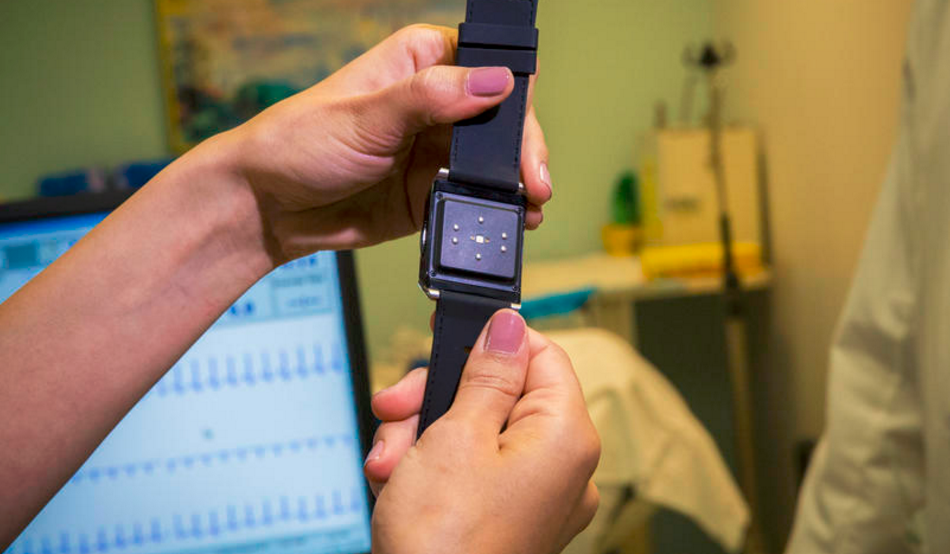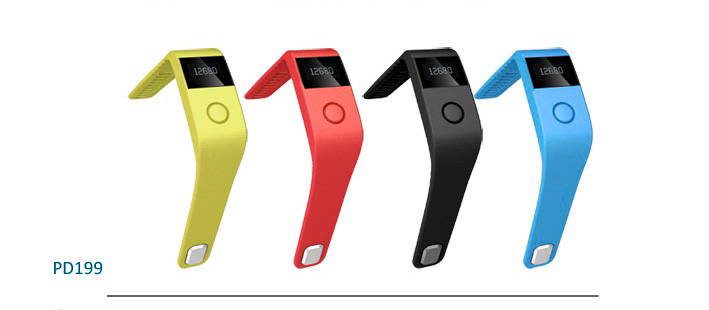There may be a problem with your fitness tracker: it could be misreporting your pulse. Mine did, though it took a cardiologist to tell me so.
As I stood on a treadmill in his office with an EKG machine connected to my chest, Dr. Jon Zaroff said my heart rate was 146. But as I glanced down at my Basis Carbon Steel device, with my heart rate quickly dropping, it still said I was at 93. Even after repeat tests done in a doctor’s office, the finding wasn’t a fluke — the band was way off.
I put five leading smart devices with heart rate monitors to the test, measuring their accuracy with an EKG and the help of Dr. Zaroff, a cardiologist at Kaiser Permanente medical center in San Francisco. You can find my results below, but it seems the optical sensing technology used in many of today’s new, wrist-based mobile heart rate monitors is sometimes inaccurate. That’s in comparison to time-tested EKG machines (or the heart rate monitors that emulate them), which sense the electrical impulses that trigger your heartbeats.
For the casual user looking to get a resting heart rate, wrist-based devices are fine. No manufacturer claims that these bands work for extreme athletes, and most make it clear that this style of band is for casual use only — never for medical use — and that they work only when you’re still. Usually, manufacturers package the heart-rate sensing technology with tried-and-true motion sensors that track steps and activity, too.
But aside from gauging huffing and puffing, heart rate tracking during exercise is one of the best ways to evaluate overall fitness. If you’re looking to hit a target heart rate while moving, you may be better off using a chest-strap device or even the ol’ finger-to-the-wrist method.
Human anatomy challenges sensors
Small, bracelet-sized trackers like the Basis Carbon Steel, the Samsung Gear Fit, and the Withings Pulse O2 tout the ability to improve the wearer’s life through heart rate monitoring, and in some cases, empower them to share that data with a doctor. But as Dr. Zaroff explained, getting an accurate heart rate using wrist-based sensors is difficult.
Biology makes optical sensing a complex and challenging task. Unlike chest strap heart rate monitors — which closely emulate a real EKG machine by measuring electrical pulse — these devices use light to track your blood. By illuminating your capillaries with an LED, a sensor adjacent to the light measures the frequency at which your blood pumps past (aka your heart rate). Moments later, you’ve got a BPM (beats per minute) reading.
To accomplish these readings, optical sensing requires you to hold absolutely still — no talking, no moving, no muscle-tensing, no sweating, no smudging allowed. Thankfully, these devices will tell you when you’re too active for them to work. (Three of the devices we tested flashed warnings to enforce peace and quiet during testing.)
There’s another complication, too. By the time blood reaches the capillaries in your wrist, it has already slowed down to a rate that doesn’t necessarily reflect your true heart rate — especially, as Dr. Zaroff explained, at BPMs above 100. (Interestingly, and as we found in our tests, the arterial vessels in our fingertips do accurately reflect our heart rate, even at very high BPMs.)
Putting the mobile heart rate monitor to the test
Because non-medical heart rate monitors aren’t regulated by the US Food and Drug Administration(FDA), their accuracy is a mystery, so I set out to conduct real-world tests against the touchstone of heart rate monitoring, an EKG.
The test
Five devices were chosen for testing: the Garmin VivoFit, the Basis Carbon Steel, the Withings Pulse O2, the Samsung Gear Fit, and the Samsung Galaxy S5 (a phone with a fingertip sensor, for good measure).
I performed two tests for each: three measurements at rest and three immediately after running on a treadmill. The latter required me to stop running completely, as all devices (except for the chest strap), need the user to be completely still to get a reading.
The results were clear: most of the trackers employing optical sensors were only accurate (or close to accurate) at my normal resting heart rate of about 70-80 BPM. The Garmin VivoFit, a device that employs a chest strap, was expectedly dead-on at accelerated rates after exercise, however.
| Device | Error (%) at 80-90 BPM | Error (%) at 160-170 BPM |
|---|---|---|
| Garmin VivoFit | 10.7 | 0 |
| Withings Pulse O2 | 5.3 | 57.1 |
| Basis Carbon Steel | 10.2 | 57.9 |
| Samsung Gear Fit | 4.2 | Unable to read |
| Samsung Galaxy S5 | 3.1 | 0.2 |
Devices with optical sensors that read the wrist (instead of the fingertip) had the most trouble tracking heart rate. These include the Basis Carbon Steel and the Gear Fit. Both either errored out in multiple tests or were significantly inaccurate compared to the EKG post-exertion, supporting the idea that optical monitors are challenged by quick pulsations.
In contrast, the Samsung Galaxy S5, a phone with a built-in monitor that measures heart rate from your fingertip using an optical sensor, tested almost exactly in sync with the EKG.
The Galaxy S5’s accuracy again comes down to biology. Unlike the narrow, slow-pumping capillaries in your wrist, there is an arterial vessel at the tip of your forefinger. It keeps up with the even the fastest pulsations of your heart, and thanks to the transluscency of the fingertip’s skin, it’s easy to read.
Wrist-based sensors face the most challenges
Even at rest, devices like the Basis Carbon Steel and the Samsung Gear Fit face difficulties beyond just capillary-reading.
One potential issue is skin pigmentation. As Bharat Vasan, COO and co-founder of Basis explained, “The light has to penetrate through several layers…and so the higher the person is on the Fitzpatrick scale (a measure of skin tone), the more difficult it is for light to bounce back. For someone who is very pale in a very brightly-lit setting, the light could get washed out. The skin color issue is something that our technology compensates for. The darker the skin, the brighter the light shines, the lighter [the skin] the less it shines.”
We’ve heard from CNET readers regarding these issues. Regarding the Samsung Gear 2, YaBoyMartell chimed in, “If you have a dark complexion, the heart rate monitor will not work! I’m not even that dark and it works 0 percent of the time. If I move the sensor to my fingertip (a lighter part of my hand), it works perfectly.”
A number of factors may affect the accuracy of these heart rate monitors, a sentiment stressed by both Basis and Samsung. Designed for use during rest, the products will not tolerate much movement or interruption during readings. Samsung further suggested to me, “To ensure the most accurate reading possible on our devices, we recommend sitting still during measurement or adjusting the device sensor so it is close to your veins.”
When asked about the inaccuracies, both Basis and Withings offered replacement units and expressed confidence in their devices’ abilities to measure heart rates accurately. Basis asserts that its device does measure accelerated heart rates, even at very high BPMs, and I look forward to another round of tests on replacement devices.
What’s left for optical heart rate monitors?
If you’ve bought one of these wrist-based devices, you’re left with one option: use them to track somewhat-accurate heart rate during rest, the benefits of which are slim to none for most people, but lean on their other features — activity tracking and sleep tracking — to improve your health and fitness.
“If it’s just a normal person and a normal heart rhythm, I don’t think [tracking heart rate during rest] changes their life that much,” Dr. Zaroff said. In some cases, he explains, a person might see their resting heart rate slow down after many months of exercise and physical improvement. Otherwise, that use case is better left for heart patients with arrhythmias or other conditions requiring constant monitoring.


